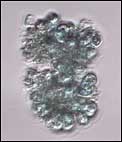Future Biodiesel: LiveFuels – algae-to-biocrude
Posted By RichC on November 12, 2007
 LiveFuels Inc. is an alliance of scientists expecting to make algae ‘biocrude’ a viable biodiesel oil source by 2010. They believe if the Manhattan Project took only 3 years that their project can be done in 4 years. The alliance is being lead by Sandia National Laboratories, a U.S. Department of Energy Nation Laboratory and they expect to sponsor dozens of labs and hundreds of scientists. According to Lissa Morgenthaler-Jones, CEO of LiveFuels, she believes they have the “expertise in process engineering, bioscience and biotechnology” to create ‘biocrude’ from algae that will be able to be processed into biodiesel by the “millions of barrels of biocrude oil per day.” She states that “the initial focus of LiveFuels’ team will be algae-to-biocrude.”
LiveFuels Inc. is an alliance of scientists expecting to make algae ‘biocrude’ a viable biodiesel oil source by 2010. They believe if the Manhattan Project took only 3 years that their project can be done in 4 years. The alliance is being lead by Sandia National Laboratories, a U.S. Department of Energy Nation Laboratory and they expect to sponsor dozens of labs and hundreds of scientists. According to Lissa Morgenthaler-Jones, CEO of LiveFuels, she believes they have the “expertise in process engineering, bioscience and biotechnology” to create ‘biocrude’ from algae that will be able to be processed into biodiesel by the “millions of barrels of biocrude oil per day.” She states that “the initial focus of LiveFuels’ team will be algae-to-biocrude.”
Here’s a segment about “algae-to-biocrude” from their site:
Algal oil is similar to soybean oil but can be grown on marginal lands unsuitable for food crops. Thriving on sunlight and CO2, algae can be grown in fresh or brackish water. This makes algae an ideal solution for farmers dealing with issues of agricultural run-off. Moreover, a shortage of vegetable oil has been predicted within 3 to 5 years in the United States, and algal oil could fill the gap for non-edible uses like biofuels.
In order to make biocrude for less than $60 a barrel, algae must be high in fats or oils. Commercially-grown algae like Spirulina are high in protein and starch but low in fat. A few high-fat species of algae like Haematococcus are promising, but the fats — at prices around $1,200 a pound — are too expensive to fuel America’s vehicles today.
“Fat algae†doesn’t sound like a biocrude oil feedstock, but the petroleum we use today is derived from prehistoric biomass (including algae). Nature’s biomass decomposition process occurred over millions of years under conditions of enormous heat and pressure. Much of the petroleum we use today began some 200 million years ago in the Carboniferous Period. The deposits of oil pumped from the North Sea, for example, consist partly of decomposed haptophyte algae called coccolithophorids.
The challenge facing LiveFuels’ scientists will be growing and transforming algae cheaply into biocrude within days rather than millennia. The entire United States’ supply of imported oil could potentially be grown on 20 to 40 million acres of marginal land, leaving the 450 million acres of fertile American soil that are presently farmland still available to feed the nation.
“LiveFuels will enable American farmers to replace imported oil with home-grown biocrude and supply it to the United States,†said Morgenthaler-Jones. “Other countries are ahead of the U.S. in biocrude research, but other countries were once ahead of us in the space race too. America put a man on the moon in eight years, and America can make its own biocrude in four.â€
CNET recently did an interview segment with Lissa Morgenthaler-Jones that I’ll include below:
Comments